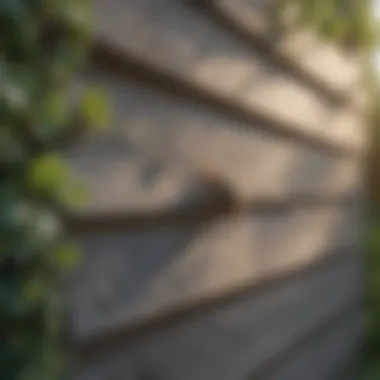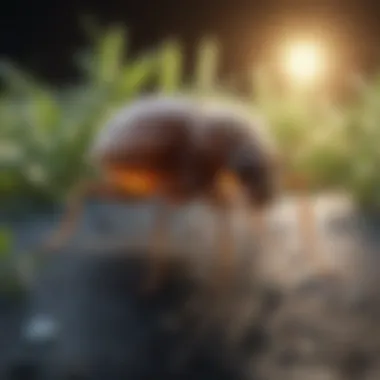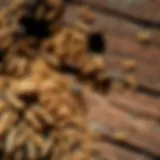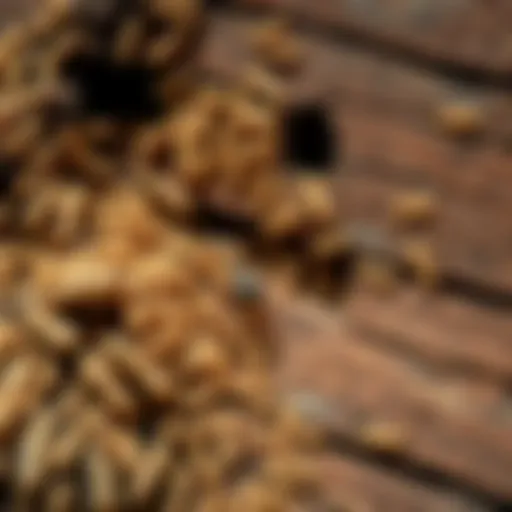Effective Strategies to Exterminate Clover Mites


Intro
Clover mites, small arachnids that often invade homes and gardens, can be a source of frustration for homeowners. Understanding how to identify and exterminate these pests is crucial. This article aims to provide a thorough overview of clover mites, focusing on identification, prevention, and treatment. Homeowners can benefit from knowing the signs of an infestation and how to manage their presence effectively.
Pest Identification
Identifying clover mites is the first step in managing their invasion. Clover mites are tiny, measuring only about 1/30 of an inch. They are typically red or greenish and have oval-shaped bodies. Clover mites often leave reddish stains when crushed, which can be a significant sign of their presence.
Signs that you may have a clover mite infestation include:
- Visible mites on windowsills, walls, or plants
- Reddish stains from crushed mites
- Webbing in corners or on plants, although they do not produce webs like spiders.
The invasion commonly occurs during spring and fall, when conditions are favorable for their population growth. Understanding these signs can help homeowners act quickly.
Prevention Strategies
Preventing an infestation of clover mites is often easier than dealing with one after it occurs. Here are some crucial home maintenance tips:
- Seal cracks and gaps. Ensure that windows and doors are properly sealed. Mites can enter through very small openings.
- Maintain a clean environment. Regular cleaning of window sills and surrounding areas decreases food sources for these pests.
- Control outdoor vegetation. Keeping grass and plants trimmed reduces the chances of mite invasion.
Natural deterrents can also be beneficial:
- Diatomaceous earth is a non-toxic powder that can be spread around areas where mites are seen to deter their movement.
- Essential oils like peppermint or tea tree can act as natural repellents. Dilute these oils in water and spray around entry points.
Treatment Options
When prevention fails, knowing treatment options is essential. Homeowners can choose between chemical and natural treatments.
Chemical Treatments
Chemical solutions can provide quick results. Read the labels carefully and follow instructions. Some commonly used insecticides include:
- Permethrin
- Bifenthrin
Natural Treatments
For those preferring eco-friendly methods, the following steps can be taken:
- Identify the infested areas. Focus on locations where you see multiple mites.
- Create a solution. Mix water with natural insecticidal soap or essential oils.
- Apply directly to infested areas. Use a spray bottle for even coverage.
It is important to monitor treated areas regularly and repeat treatments as necessary.
"Prevention is often more effective than treatment. By understanding the behavior of clover mites, homeowners can implement strategic measures to avoid infestations."
Understanding clover mites is key for homeowners looking to protect their properties and gardens. Through effective identification and a mix of prevention and treatment options, the impact of these pests can be significantly reduced.
Understanding Clover Mites
Clover mites are tiny pests that often invade homes and gardens, creating an array of problems for homeowners. Understanding their biology, behavior, and lifecycle is crucial for effective management. Knowing how these mites operate helps in implementing strategies that can either prevent or eradicate them entirely. Their presence is not just an inconvenience; they can damage plants and create unsightly marks on walls and surfaces. This section lays the foundation for dealing with these pests rigorously and comprehensively.
Biology and Life Cycle
Description and Characteristics
Clover mites are small arachnids, measuring about 0.75 mm in size. Their body appears reddish-brown, which can make them more noticeable on light surfaces. One salient characteristic of clover mites is their ability to multiply quickly. A singular female can lay hundreds of eggs, which fosters rapid infestations. This high fecundity underlines the necessity of swift action when dealing with them.
More specifically, clover mites are noteworthy for their uniquely adapted legs, which allow for easy movement across various surfaces. This trait is advantageous as it enables them to explore and invade multiple areas, including homes. Their small size can be a disadvantage for detection, but understanding these characteristics assists homeowners in identifying potential infestations early.
Life Cycle Stages
Clover mites undergo a simple life cycle consisting of four main stages: egg, larva, nymph, and adult. The life cycle typically starts in spring when the eggs hatch. Each stage contributes to the next, creating a continuous cycle of reproduction and potential infestation.
What makes the life cycle significant is the speed of development. Under favorable conditions, clover mites can complete their life cycle in as few as two weeks. This rapid progression highlights why prompt action is essential when any signs of these pests are noticed. If left unchecked, they can quickly escalate from a manageable presence to a full-blown infestation.


Habitat Preferences
Clover mites prefer warm and humid environments. They thrive in areas with ample vegetation and often make their home on the outer edges of lawns or gardens. Furthermore, these mites are frequent visitors to homes in spring and fall, seeking shelter from adverse weather conditions.
An important aspect of their habitat preference is their tendency to inhabit the bases of plants where moisture is higher and food sources are plentiful. Understanding this preference helps homeowners identify potential hiding spots and take preventive measures, such as maintaining dry conditions near plants and sealing entry points into the home to block invading crowds.
Behavior Patterns
Feeding Habits
Clover mites feed on the sap of plants, which can lead to noticeable damage, especially to delicate species. Their feeding creates small yellow or brown spots on leaves, ultimately leading to plant stress or death.
This further establishes why their habits are pivotal to understand. Being aware of their diet can assist in preemptively managing plant health, as well as informing decisions on pest control methods that are safe for biodiversity.
Seasonal Activity
Clover mites show seasonal patterns in activity, being more prevalent during warmer months. Generally, they become noticeable in spring when temperatures rise. They can remain inactive during colder temperatures but may seek shelter in homes, thus increasing the chance of an infestation.
Recognizing these seasonal habits is advantageous for timing preventive actions. Homeowners can make informed decisions about periodic checks or treatments tailored to coincide with peak activity times.
Common Hiding Spots
Clover mites commonly hide in small crevices, under foliage, and along the edges of walls. They are particularly attracted to cracks caused by structural imperfections in homes.
This knowledge is essential as it guides consumers in developing an inspection routine for these areas. By focusing on these hiding spots, the likelihood of detection increases, allowing for timely action.
By understanding these behaviors and characteristics, homeowners can better equip themselves with the knowledge necessary for effective clover mite management.
Identifying Clover Mite Infestations
Recognizing a clover mite infestation is crucial for maintaining the integrity of your home ecosystem. These tiny pests, while small, can cause significant annoyance and damage if left unchecked. The sooner you identify their presence, the more effective your extermination efforts will be.
Signs of Infestation
Visible Clusters
Visible clusters of clover mites are often the first sign of an infestation. These tiny, reddish-brown mites can appear in large numbers, making them noticeable to the naked eye. When you observe these clusters on windowsills or walls, it indicates a growing population. Early detection through visible clusters allows for prompt action.
Advantages of recognizing these clusters include the ability to target extermination efforts effectively. However, visible clusters can also be misleading, as they may lead homeowners to believe the problem is much larger than it is, which can cause unnecessary worry. Therefore, it is essential to approach this sign with a balanced perspective.
Damage to Plants
Another critical indicator of clover mite presence is damage to your plants. These pests feed on plant cells, which can result in wilting or discoloration. You'll often notice yellow or brown patches on leaves as the mites suck out vital nutrients.
Understanding the scope of damage to plants is vital. If clover mites are present, they can quickly spread through your garden. Minimal damage can be repaired, but extensive damage may weaken or even kill the plants. This aspect of identifying infestations signifies the urgency required in response.
Presence of Red Marks
Finding red marks on surfaces where clover mites have been active is another tell-tale sign. These stains are often confused with spilled substances but can indicate the presence of these tiny pests. The red marks occur due to the excrement of the mites.
Identifying these red marks helps homeowners track the movement and activity level of clover mites within the property. While these marks may not be harmful in themselves, they serve as a warning signal that infestations might be growing. Being aware of such indicators facilitates timely preventive actions.
Distinguishing from Other Pests
Comparison with Spider Mites
Clover mites are sometimes confused with spider mites. Both possess similar characteristics; however, a closer inspection reveals key differences. Spider mites tend to weave webs on plants, which is not typical behavior for clover mites. Understanding these differences is critical, as misidentifying the pest can lead to ineffective treatment methods.
Knowing how to distinguish between these pests ensures that the correct extermination methods are employed. This knowledge prevents unnecessary expense and time, safeguarding your plants and home more effectively.
Imposters and Lookalikes
There are many pests resembling clover mites, which can complicate identification efforts. Some common imposters include various species of tiny beetles or other mite types. Misidentifying these pests can result in overlooking an infestation or applying inappropriate control techniques.


Understanding the unique features of clover mites compared to impostors is essential for effective pest management. A detailed examination of body shape and coloration can help ensure accurate recognition. This careful attention to detail reinforces the importance of informed decision-making in pest control efforts.
Preventing Clover Mite Infestations
Preventing clover mite infestations is essential for maintaining a healthy environment in homes and gardens. Clover mites can reproduce rapidly and become a nuisance if left unchecked. The benefits of prevention are clear: it saves time and resources that would otherwise be spent on extermination efforts. Moreover, prevention helps in maintaining the overall aesthetic and health of plants, decreasing the likelihood of damage they cause. By implementing effective strategies, one can minimize the risk of infestations.
Home Maintenance Strategies
Sealing Entry Points
Sealing entry points is a fundamental strategy in preventing clover mite infestations. Clover mites can easily enter homes through very small gaps and cracks around windows, doors, and foundations. The key characteristic of this method is its proactive nature. By closing the pathways, you effectively reduce the chances of these pests gaining access to the indoor environment.
A unique feature of sealing entry points is that it not only prevents clover mites but also offers benefits against many other household pests. However, it is essential to ensure that any materials used for sealing, such as caulk or weather stripping, are applied properly for maximum effect.
Proper Ventilation
Good ventilation is another critical aspect. Proper ventilation helps to regulate humidity levels within the home, which can deter clover mites and other pests. High humidity creates an ideal environment for mites to thrive, so controlling air circulation is vital. The primary characteristic of this strategy is its use of airflow to maintain an unsuitable habitat for pests.
Ventilation can also enhance indoor air quality, creating a more pleasant living space. Although this method requires consistent maintenance, its long-term benefits, such as energy savings and comfort, far outweigh the downsides.
Maintaining Cleanliness
Keeping a clean environment is essential for preventing clover mite infestations. Regular cleaning routines can significantly reduce debris and clutter that can provide hiding spots for pests. The key characteristic of cleanliness is its simplicity and effectiveness. It is a popular choice because it incorporates regular habits that enhance overall living conditions.
A unique feature is that maintaining cleanliness not only prevents clover mites but also contributes to the overall well-being of inhabitants. Areas that are frequently cleaned are less likely to attract pests. However, this practice requires diligence and commitment to regular cleaning schedules to ensure effectiveness.
Landscaping Practices
Choosing Plants Wisely
Choosing plants wisely is a significant aspect of preventing clover mite infestations in the garden. Certain plants are less appealing to clover mites, which can naturally discourage their presence. The key characteristic of this practice is its proactive selection based on pest preferences. By incorporating such plants, households promote a less inviting environment for clover mites.
Moreover, selecting appropriate plants can enhance the aesthetic value of the garden. However, care must be taken to choose plants compatible with the existing environment and conditions, as missteps could lead to other issues.
Managing Ground Cover
Managing ground cover effectively helps in deterring clover mites. Properly chosen ground cover can inhibit the growth of clover mites while providing an appealing landscape. The main characteristic is its ability to create unfavorable conditions for the mites. This practice is beneficial as it promotes healthy growth and minimizes potential infestations.
However, ground covers must be maintained properly. Overgrowth can become a shelter for pests, possibly leading to infestations if not controlled.
Proper Watering Techniques
Implementing proper watering techniques contributes significantly to preventing clover mite infestations. Overwatering creates conditions conducive to pests, while appropriate watering encourages healthy plants that can better withstand pest presence. The primary characteristic of this approach is its focus on moisture management.
Proper watering can also reduce fungal growth, which can attract pests. Nevertheless, it is important to find a balance in watering techniques, as both drought and overwatering have their disadvantages.
"An ounce of prevention is worth a pound of cure."
By utilizing these methods, homeowners can create an environment less conducive to clover mites. Each aspect plays a vital role in maintaining a healthy and pest-free space.
Methods for Extermination
In order to effectively manage clover mite populations, understanding various extermination methods is critical. These methods can be categorized into natural options and chemical strategies. Each approach has its own advantages, making it essential to select the right method based on the specific infestation level and personal preferences. By employing a combination of techniques, homeowners can not only exterminate existing mites but also reduce the risk of future infestations.
Natural Extermination Options
Natural solutions are often preferred by those seeking a less toxic approach to pest control. They utilize readily available ingredients and are generally safer for the environment and family members.
Essential Oils and Vinegar
Essential oils and vinegar have gained popularity as effective natural deterrents against clover mites. The strong scents of oils like peppermint or rosemary can repel these tiny pests. Vinegar, on the other hand, disrupts their biological functions when applied directly. This option is affordable and easy to prepare, making it appealing for those looking for a cost-effective solution. However, while natural, it may require more frequent applications compared to synthetic chemicals.
Homemade Sprays


Homemade sprays take advantage of common household ingredients to combat clover mites. These can include mixtures of water, soap, and a few drops of essential oils. The soap acts as a suffocating agent, while the oil provides additional repellent properties. Using homemade sprays allows for customized formulations that suit specific situations. Yet, the effectiveness can vary based on the ingredients and the severity of the infestation.
Traps and Barriers
Traps and barriers serve as preventive measures in addition to extermination. Simple devices such as sticky traps or physical barriers can minimize the likelihood of an infestation becoming established. They work by catching mites before they can enter the living space. While they may not eliminate existing populations, they are a crucial part of an overall pest management strategy. Their simplicity and low-risk nature make them a popular choice, although ongoing maintenance is necessary to ensure effectiveness.
Chemical Extermination Methods
For those facing severe infestations, chemical solutions might present a more immediate answer. These methods can offer quick results, but they come with their own set of considerations that must not be overlooked.
Over-the-Counter Solutions
Over-the-counter solutions provide an accessible way for homeowners to address clover mite issues. These products typically contain miticides that target pests effectively. They are easy to find in gardening or home improvement stores. The key advantage here is their speed of action, often showing results within hours. Nevertheless, users must carefully follow instructions, as misuse can lead to health risks or environmental harm.
Professional Pest Control Services
For individuals looking for a comprehensive approach, professional pest control services may be the best route. Trained exterminators bring expertise and specialized tools to tackle clover mite infestations. This method ensures a thorough assessment and treatment plan tailored to individual needs. The main drawback is the cost and the necessity of scheduling, which might not fit everyone’s busy lives. However, the peace of mind and thoroughness of professional services can outweigh these concerns.
Safety Considerations
When employing any extermination method, safety considerations should always be at the forefront. Proper handling of chemicals is essential to protect inhabitants and pets. Reading labels and using protective gear when handling products is strongly advised. This approach also includes ensuring proper ventilation during and after treatment application. It's crucial to weigh the benefits against risks, especially when children or sensitive individuals are in the household.
Post-Extermination Care
Post-extermination care is a crucial aspect of managing clover mites after treating an infestation. This phase not only determines the success of the extermination efforts but also plays a key role in preventing future outbreaks. Ensuring that your environment is monitored and maintained effectively can greatly reduce the chances of clover mites returning, which ultimately saves both time and money.
Monitoring for Re-Infestation
Regular Inspections
Regular inspections are essential for detecting any signs of clover mite re-infestation. This involves checking known infestation areas such as windows, baseboards, and gardens. The key characteristic of regular inspections is their proactive nature. They allow for early detection, which is a beneficial choice in this context because it helps prevent a small problem from becoming a larger one.
A unique feature of regular inspections is the ability to identify patterns over time. Homeowners may notice recurring hotspots, which can inform future preventive measures. While beneficial, regular inspections may require commitment and diligence. If missed, they could lead to increased stress and possible financial burden from renewed infestations.
Preventive Measures Review
Preventive measures review is about evaluating the effectiveness of the strategies implemented after extermination. This includes checking the gaps sealed, the effectiveness of barriers, and the cleanliness of the area. The key characteristic of a preventive measures review is its comprehensive nature that covers all aspects of pest management. It is a popular choice among many homeowners since it helps ensure that proactive actions remain effective over time.
A unique feature of preventive measures review is its emphasis on continuous improvement. Homeowners can adapt their methods based on what is working or not. This can include changing up cleaning routines or adjusting landscaping practices. On the downside, the review process can seem tedious and time-consuming. However, the long-term benefits of avoiding pest resurgence far outweigh such inconveniences.
Long-Term Strategies
Implementing Integrated Pest Management
Implementing Integrated Pest Management (IPM) involves a holistic approach that combines different management practices to control clover mites effectively. Its contribution to pest control lies in its reliance on understanding pest biology, as well as the application of environmentally sound practices. The key characteristic of IPM is its effectiveness. It reduces reliance on chemical treatments, which can be advantageous for health and the environment.
A unique feature of IPM is its adaptability. Homeowners can tailor their approaches based on their specific environments and pest pressures. However, IPM may require more knowledge and time to implement than straightforward chemical solutions, which could be challenging for some homeowners.
Educating Residents and Family Members
Educating residents and family members about clover mites and pest management strategies is a fundamental aspect of long-term control. This does not only arm household members with knowledge, but it also fosters a community spirit towards maintaining a pest-free environment. The key characteristic here is engagement, making everyone aware of signs of infestation and the importance of prevention measures. This choice is beneficial because it establishes a collective responsibility for pest management.
A unique aspect of educating household members is creating a culture of awareness. When everyone understands the issue, they can actively participate in monitoring and maintaining prevention strategies. The downside might be the initial resistance from family members who may feel overwhelmed by additional responsibilities, but with patience and clarity, they can be brought on board.
Closure
Understanding how to effectively manage clover mites is essential for every homeowner or gardener. These tiny pests can disrupt the tranquility of your living space and affect the health of your plants. Tackling the issue requires a comprehensive approach, one that incorporates identification, prevention, and a variety of extermination methods.
A key benefit of this knowledge lies in the empowerment it brings homeowners. By recognizing the signs of infestation, understanding the pest's lifecycle, and implementing effective prevention strategies, individuals can significantly minimize the risk of a full-blown invasion. Additionally, knowing the various natural and chemical methods available equips you to respond promptly if clover mites do become problematic.
While it is crucial to eradicate these pests when they invade, it is equally important to monitor for potential re-infestation after extermination. This means engaging in regular inspections and maintaining the preventive measures established previously. The integration of information shared across this article aids in forming a cohesive strategy that can effectively manage clover mite populations.
"Prevention, identification, and tailored extermination methods are vital to ensuring a pest-free environment."
Ultimately, the approaches discussed provide homeowners useful insight into how to manage their gardening space and maintain a comfortable home environment, free from the disturbances caused by clover mites.
Summary of Key Points
- Clover mites are persistent pests that require immediate attention once an infestation is detected.
- Regular inspections for visible signs can help catch infestations early.
- Proper home maintenance strategies such as sealing entry points and maintaining cleanliness are essential for prevention.
- Various extermination methods, both natural and chemical, can effectively eliminate clover mites.
- Post-extermination monitoring and long-term strategies are vital to ensure that clover mites do not return.



